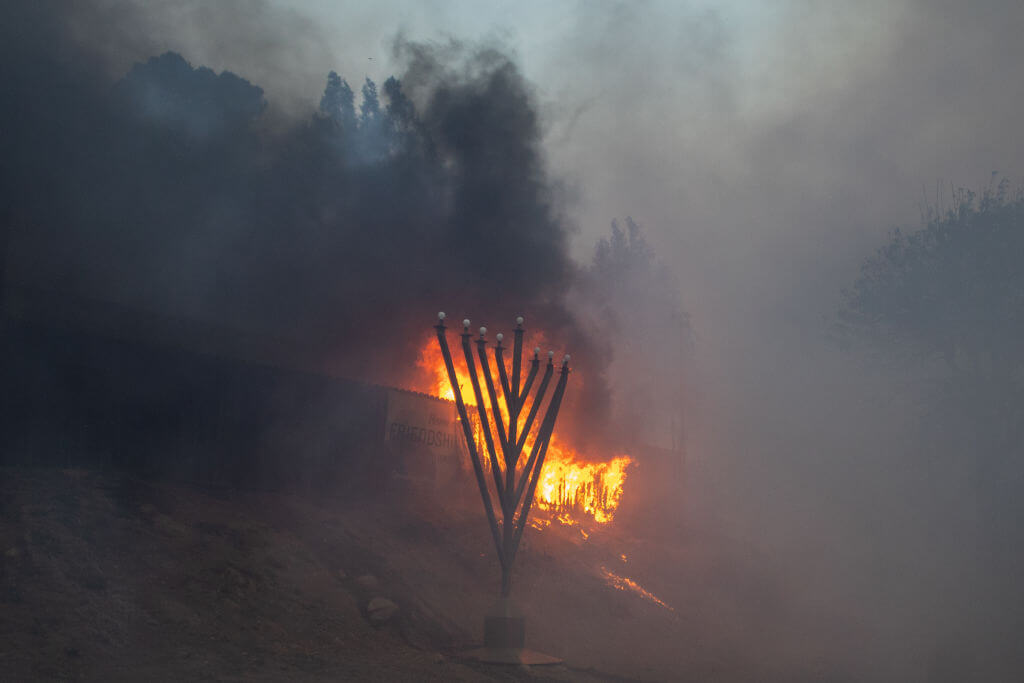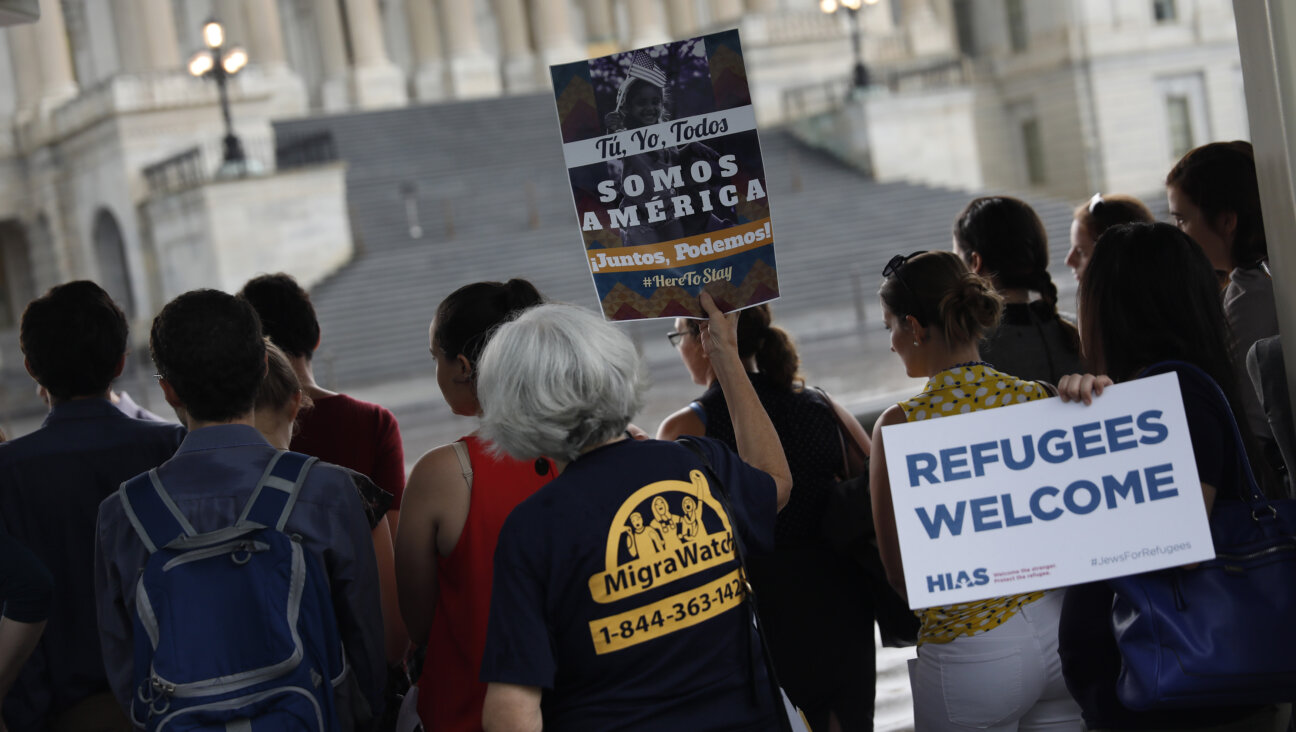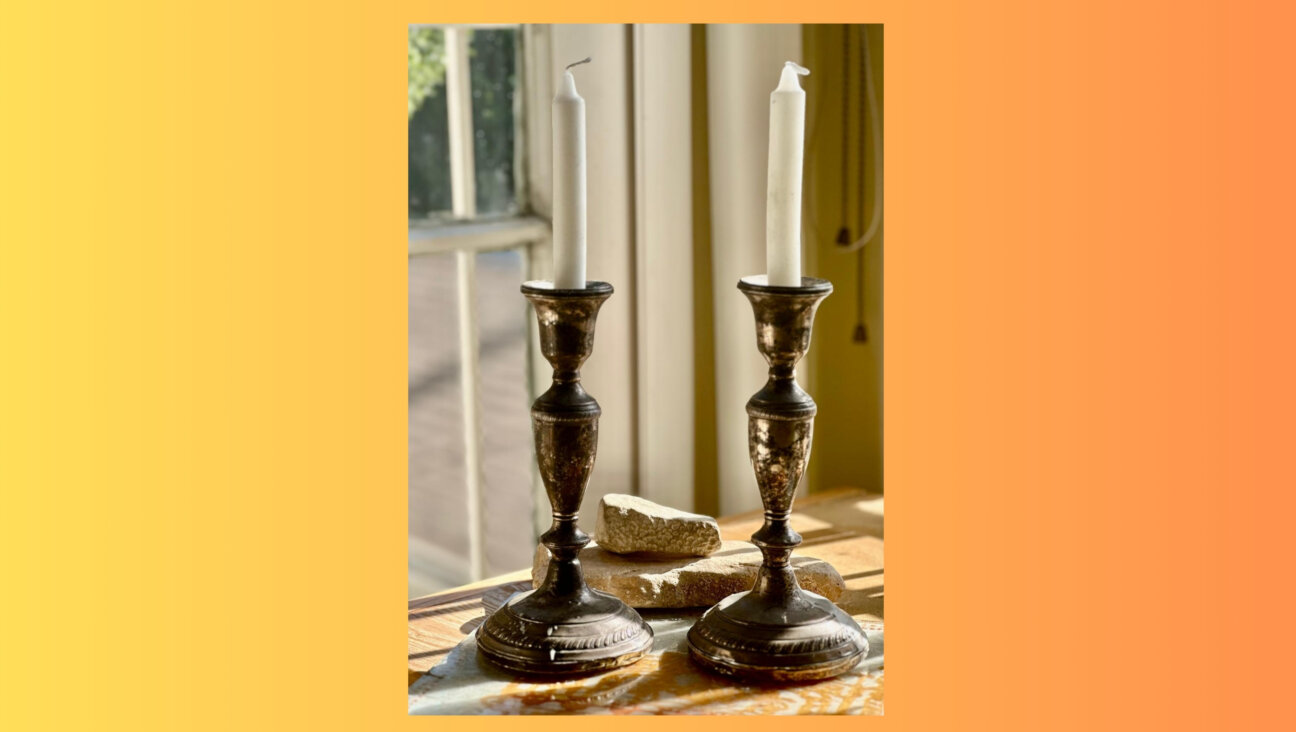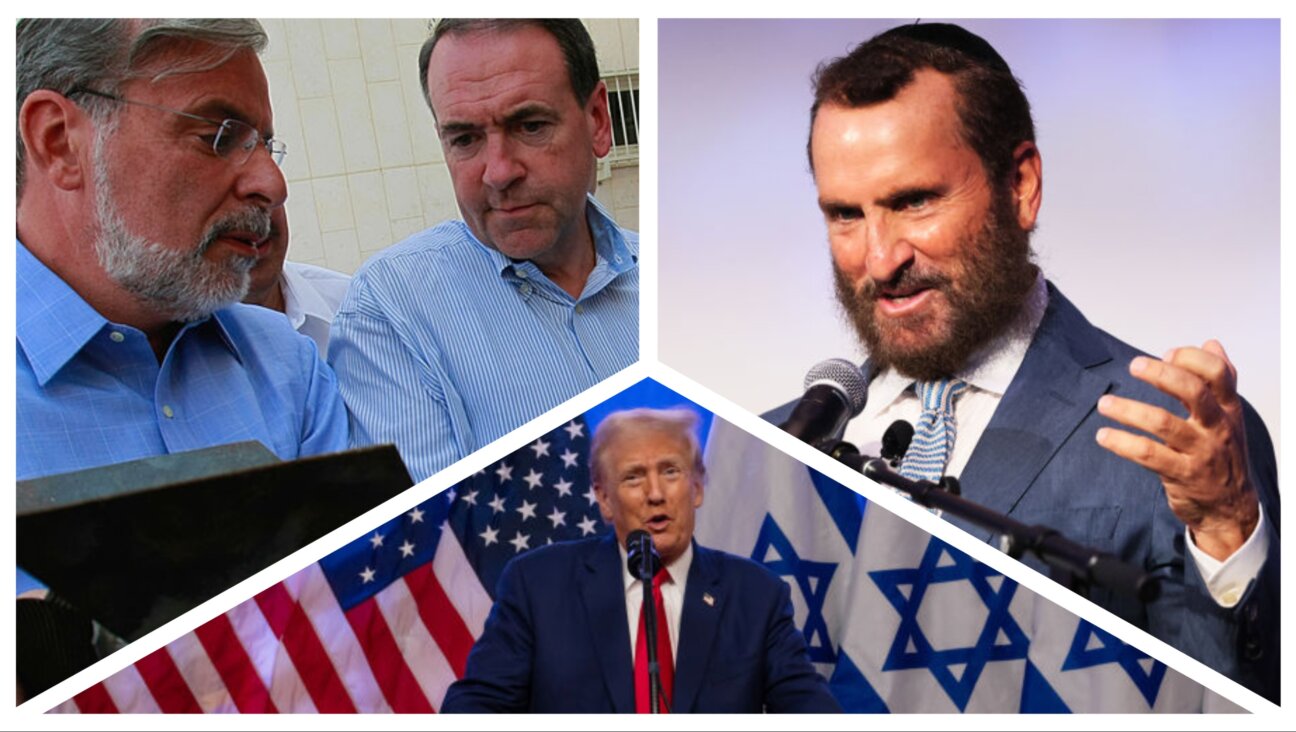Planting Seeds of Mideast Peace in Time of War
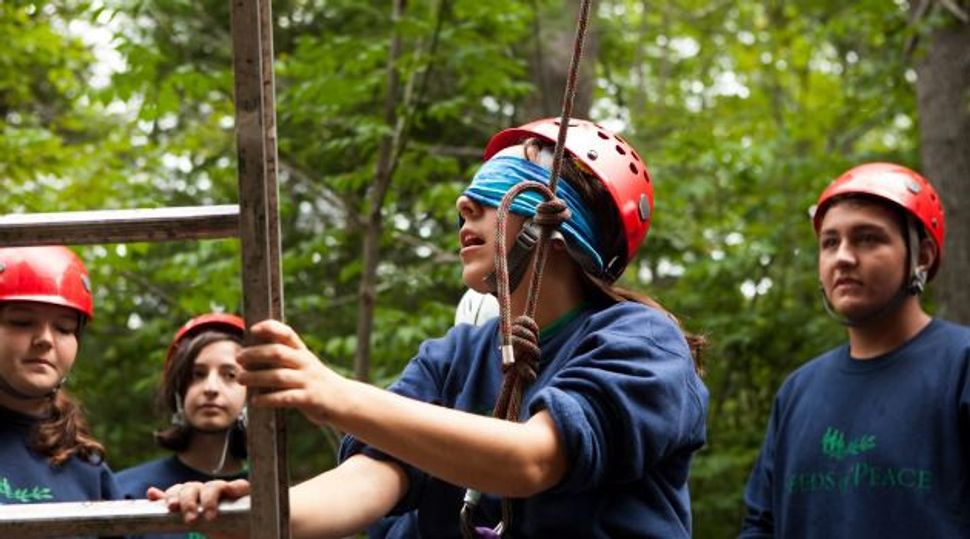
Image by Greta Rybus
“My name is Mustafa, and I am from Gaza,” declared the 16-year-old perched, however improbably, on a picnic table near the shore of Pleasant Lake, Maine. His backdrop — just days after sheltering from the Israeli mortars exploding near his home — was New England’s White Mountains. “I lived 20 days in third war. I come to Seeds of Peace camp to share my suffering.”
Despite his peach-fuzz mustache, Mustafa speaks with the responsibility of a foreign ambassador and in a way, he is one: He’s one of just two Gazans who made it out to this rustic camp setting during the recent war. And now he’s primed to participate in the latest annual gathering of children from Israel, the Israeli-occupied territories, nearby Arab countries and America in a privileged summer camp: an idyll of sports, games, good times — and intense, life-wrenching encounters with children from other groups whom many of them have been conditioned to see as mortal enemies.
Seeds of Peace, the hopeful brainchild of a Washington journalist in the early 1990s, has been growing for 22 years now. But the well-funded summer camp, which plucks an elite group of teenagers out of the cauldron of the Middle East and sets them down in the wilds of Northern Maine each year, is taking place this August in the immediate aftermath of the third, and bloodiest, Israeli military incursion into Gaza since 2008.
When John Wallach, then the foreign editor of Hearst Newspapers, hatched the concept of the camp as a peacemaking venture, the Israeli-Palestinian conflict was already many decades old; Israel’s occupation of the West Bank and Gaza had been in place for 26 years; thousands and thousands had been killed.
Wallach believed that a good part of the conflict’s intractability was due to the mutual demonization of the people on the other side. Amid the burst of optimism during the era of the 1993 Oslo peace talks, he convinced Israel’s then-foreign minister, Shimon Peres, and officials from Egypt and the Palestine Liberation Organization to send 15 boys each to launch the camp the next summer. Five thousand two hundred graduates later, the camp’s mission has grown to include girls, and also teens from other conflict areas whose people are at similar loggerheads: South Asians, Greeks and Turks.
But Mustafa would seem to be just the kind of kid Wallach, who died in 2002, had in mind for the camp’s original and still-core mission. Since he was 10, the Gazan teen has experienced three wars firsthand and at close quarters: 2008, 2012 and today. He’s watched bombs fall all around him, killing large families long respected in his community and destroying the American International School, which he attends.
“I can live with Jews, but I can’t live with Israelis,” he told me during the course of our conversations. (Like most of the campers interviewed for this article, Mustafa embraced the camp’s policy barring the media’s use of their last names to protect their privacy.) Israelis must choose to live “with” him in Palestine, he said — a land he envisions as stretching from the Mediterranean to the Jordan River — or go back to “Russia or wherever.”
His tone was urgent. He has come to Seeds of Peace, like many, with a motive: to tell his story and have it heard, to prove his suffering and humanity. Both have already been tested.
Over the past week, Mustafa related, some Israelis made comments that generalized all Gazans or Palestinians as “terrorists.”
“I ask my Israeli friend, ‘Am I a terrorist?’ Like this, I asked them” — Mustafa reached down and pinched the Seeds of Peace logo on his T-shirt and lifted it off his chest. The logo — three green silhouettes holding hands, with leaves sprouting out from their feet — reflects the camp’s goal of spreading understanding outward from the summer experiences of Seeds like Mustafa. It’s a message that Mustafa urgently professes.
Yet, he also stresses: “I don’t feel like Israel must be in our land. I feel they must leave our land.”
Suddenly, as we are talking, a foghorn blares from behind. “Fire Drill,” Mustafa says, and a counselor motions him to hurry. But this is no drill. The Gazan, who must be close to 200 pounds, hurtles toward the main field, where his fellow campers are gathering around a golf cart driven by Wil Smith, the camp’s associate director. Smith is gripping the steering wheel too tightly. His voice is so shaken I can only catch snippets:
“A missing camper… staff launched a waterfront sweep in search of her… found her, finally, taking a shower.”
Smith drops his head toward the wheel to hide what can only be tears. Among the distraught campers, hands rise to cover mouths. “I can’t stress how important it is to be where you’re supposed to be,” whimpers Smith. “You’re all like my children,” — he’s crying now — “and I don’t know what I would do if anything happened to any one of you.” His voice gives out.
Packed shoulder to shoulder in the camp’s mandatory green t-shirts, the mass of young Palestinians, Israelis, Jordanians, Egyptians, Pakistanis, Afghans, Indians and Americans stand silent, suddenly united. Their edged expressions reflect a shared sense of having been spared a terrible loss — not of an Israeli or a Palestinian or a Jordanian — but of a fellow Seed. For a moment, nationality is irrelevant. She is a Seed, and they are all Seeds. At least for a moment.
But the daily reality is not so “Kumbaya,“ particularly in the wake of Gaza.
Guy Zissu, a 15-year-old Israeli from Beersheba, said he, for one, was surprised to learn that the majority of Palestinians he talked to did not support a two-state solution like he did. “They will always want everything,” he said. “I thought it was just right-wingy and wrong saying that, but that’s what they want.”
I spent two days at camp. I watched kids water ski for the first time; choreograph dance routines to “Problem” by teen idol Ariana Grande, and improvise speeches about why they disliked Valentine’s Day, airplanes and spiders. I heard whispers about a mythical troll under the bridge that leads to the high-ropes course; the cries of a girl having a panic attack while hanging 30 feet up on one such rope course, and spooky loons piercing the midnight quiet of the Northern wilderness. I ate dry chicken burgers and was advised to avoid washing it down with the neon-yellow drink. I played a game called “Steal the Bacon.” I got sand between my toes. It was just like summer camp, except it wasn’t. I learned about this paradox by speaking to some two dozen campers, counselors and administrators, many for extended periods.
But the one activity that I was never allowed to participate in, witness or enter was the camp’s Dialogue Sessions. This is where the unfiltered force of strong, emotionally charged opinions from the various sides of the conflict collide head-on. For 110 minutes per day, or 70 hours over the whole three and a half week session, campers divide into carefully ethno-balanced groups of about 15. They meet in small one-room, plywood huts, built for the single purpose of dialogue. There are both Middle East dialogues (Israelis, Palestinians, Egyptians, Jordanians and Americans) and South Asian dialogues, each dealing with the unique issues surrounding the respective conflicts into which these children were born.
With trained facilitators present, the teens lay it all out. Emotions boil over, tears flow, voices shout, accusations fly and — sometimes — hugs occur. This summer, many participants, unable to contain themselves, walked out of the session at points. Shira, a 15-year-old Israeli, said that in her group, much of the intensity, including kids walking out, occurred when Gaza was mentioned.
It was this summer’s third-rail topic.
On Saturday, August 9, about a week after their arrival, most of the Palestinian campers, and some from other Arab delegations, staged an unprecedented silent sit-in, or “mourning,” as some of the Palestinians put it, for the 1,881 Gazans then killed in the latest bloody clash between Israel and Hamas. In defiance of the camp’s strict dress code, which requires all campers to wear the green Seeds of Peace T-shirts, the sit-in participants all wore shirts emblazoned with the message “Gaza: the pulse of dignity.”
Camp administrators weren’t pleased. It was not just the shirts, but also the fact that the kids skipped scheduled camp activities to hold the sit-in. Many on staff thought the Palestinians had planned the protest prior to arriving, and speculation flew that their adult delegation leader had had a hand in the scheme, and in supplying the t-shirts.
But for the Palestinians, it was a proud display of support for their countrymen in the war-ravaged territory — and a marked reminder for their fellow campers of the six Gazan kids missing from their delegation; only two of eight Gazans accepted to the camp found passage out of the locked-down strip. (Mustafa exploited his Moroccan dual citizenship at the Rafah crossing; the other, a girl, has dual American citizenship).
Shira, Mustafa and Guy are all in separate Middle East dialogue groups — one of several subdivisions, including bunk groups and table groups, that camp counselors structure with great attention to detail. The aim is to maximize connections among campers. Bunk arrangements often pair up Palestinians and Israelis to help diminish fear and distrust in even the most intimate settings. Still, a few veteran counselors said there seemed to be less intermingling this year than in the past, perhaps because of the ongoing conflict.
While every dialogue group goes through its own unique experience, there seems to be a general path they all take: After icebreakers and rule setting, the campers are usually itching to dive into the conflict. For the first week or so, they fight over “facts.” Kids batter out the talking points they’ve internalized from their governments, schools and communities. Terminology becomes a huge contest: IDF, or Israel Defense Forces, versus IOF, Israeli Occupation Forces; checkpoints versus crossing-points; security fence versus separation fence; Hamas terrorists versus IOF terrorists. These semantic arguments rarely bear fruit.
At a certain point, usually in the second week, the campers run out of new “facts” to spit out at each other. Here, facilitators step in to shift the conversation from the political to the personal.
Guy described a simulation exercise his group’s facilitator organized: As a Palestinian teen recounted his experience of getting harassed at a checkpoint by Israeli soldiers in the West Bank, the Israeli campers were instructed to act out the part of Palestinian boys. The Palestinian campers played IDF soldiers.
The Egyptians and Jordanians watched the re-enactment from their seats as the IDF “soldiers” searched the “Palestinians’” cars, bags and persons, looking for drugs or weapons. Acting out the Palestinian teen’s experience as he recounted it, the “Israelis” eventually harassed all the “Palestinians,” asking: “Why don’t you have drugs? Weapons?”
“Trying to just be mean to them,” Guy said. “I really don’t know why they would do that.” Guy said that the exercise helped him realize that, despite the soldiers’ legitimate mission to stop terrorists, Israelis are also doing many things wrong.
He reflected on all the broad points of Israeli Jewish consensus that he has internalized. “Not all of them are sacred,” the 15-year-old said. “Not all of them are completely the truth — maybe the truth for me, but it’s not a universal truth.”
Guy and many other campers said it would be insensitive and wrong to deny the feelings of pain that any individual, whether Jew or Arab, experiences — though like many at the camp, he acknowledged that the Palestinians’ personal stories were more traumatic.
“I can’t say I identify with [the Palestinians’] pain, but I really understood their pain,” Guy said. “And I think they actually listened to me, too.”
Talking to Mustafa made me wonder about that sometimes. The Israelis and Palestinians I spoke with over the course of my visit had a wide diversity of perspectives and views. But Mustafa was clear that for him, the ultimate goal was taking back all the land of Palestine, as it existed before Israel’s establishment in 1948, for the Palestinian people. The 16-year-old was not naive about the chances of this happening, though. Sometimes he sounded conflicted.
“I want peace before 1948 borders,” he said. “But I want 1948 borders also. I can’t sell my Palestine.”
He expressed a willingness to take back the land, if necessary, inch by inch. He was for a secular state, though. Despite being ruled by the Islamist group Hamas in Gaza, Mustafa refused to accept the idea of a religious state — Islamic, Christian or Jewish.
Guy said his realization that many Palestinians felt the way Mustafa did “made me lose all hope at first…. But they told us to trust the process, and I did, and in the last dialogue we had yesterday, things got better. We actually talked, and it was a calm conversation.”
Dialogue Session can easily be taken as the crux of Seeds of Peace, for without Dialogue, Camp Seeds of Peace is suddenly a lot more like just camp.
But the converse is also true: Without the games and activities, Camp Seeds of Peace is suddenly a lot more like government peace talks across cold wood tables.
The camp’s recipe for combining the two is crucial to its approach. Recreational activities and unregulated interaction, in fact, make up the major components of its formula.
The camp’s recreation program encompasses line sports, arts and waterfront activities. But the most important arena for play is Group Challenge — a physical complement to the Dialogue Sessions that pitches the members of each dialogue group into intense play with each other that requires enormous cooperation. The groups start with field games. They then graduate to low-rope climbing courses, in which members of the group must work together to get through the course.
Finally they make it to the high-rope courses, by which I mean 30 feet worth of high. They are terrifying. I was able to catch a Middle East dialogue group’s first time on the course, and I saw a lot of panic, crying and supportive cheers. There was also one of the more heartwarming, hopeful episodes I witnessed while at camp: A Palestinian and Israeli, Muhammed and Roi, were scaling the Vertical Play-Pen — a pants-wetting, log-and-rubber-tire structure vertically suspended 30-feet in the air. It’s designed to be pretty much impossible to climb solo, and Roi and Muhammed were using every limb available between the two of them to get through it.
“You can use my leg,” Muhammed said. “Your leg? Like climb your leg? I don’t think it’s a good idea,” Roi said — before climbing Muhammed’s leg. Finally, Roi pushed Muhammed’s butt through the last tire, and they were at the top. They high-fived and hugged, and I snapped an imaginary picture with my fingers.
The two were probably paired together deliberately. Group Challenge counselors organize the play groupings based on meetings they have with the dialogue facilitators. So, for instance, two kids butting heads particularly hard in Dialogue might be paired with each other during Group Challenge to help develop their relationship along a different path.
Guy described having to play games with people who call you “occupiers and terrorists,” as “weird.”
Surprisingly, though, beyond standard teenage arguments of the “What’s the score?” or “He was out!” type, most recreation activities play out without strife. Staffers tell campers to keep the political and emotional arguments in the dialogue room. And most seem to do so.
Throughout my stay, in fact, I was impressed with the stunning level of restraint and sophistication the teens displayed. The dialogues are all conducted in English, which is a first language for almost none of the participants other than the Americans. But most of the teens seem more than comfortable expressing themselves in this foreign tongue. And all seemed well informed about their region’s politics.
That’s no accident, as it turns out. In Israel, becoming a Seed is a national competition. And the process in other countries and regions is hardly less selective. The acceptance rate this past summer for applicants from all regions was 3%. Only 300 of some 9,000 global applicants got in. By comparison, Harvard’s 2014 acceptance rate was double this.
Guy said he learned about the camp from his English teacher, who asked him out of the blue, “Do you want to go to America?” Soon he was sucked into five tiers of all-English interviews sponsored by Israel’s Ministry of Education and Seeds of Peace. It’s like the process of becoming a “pilot in the air force,” Guy said.
The process in the Palestinian territories is only slightly less competitive. The road to Maine for students there required only one or two interviews, which were held exclusively under the aegis of the camp. The Palestinian Authority’s Ministry of Education has not been involved since the second intifida began, 14 years ago. Forty-five out of some 1,000 applicants were accepted — a rate of 4.5%. In the end, this is a camp that aims its impact at elites.
The camp itself, however, does not meet the standards of an elite American summer camp. There are no stalls to board your horse, nor are there flat-screen televisions, as far as I saw. Dandelions are growing on the tennis courts, as grass is on the baseball diamond. The basketball hoops rattle just a bit too much when the ball hits. The buildings look weathered, too, and the communications director, Eric Kapenga, said construction over the past two decades has been limited mostly to re-roofing, or replacing a structure destroyed by fallen tree or fire.
That’s just how it should be: the visual proof that the camp has its priorities straight. Because Seeds of Peace was not created to cater to American material culture, but to “give rise to new generations of leaders uniquely inspired and equipped to build lasting peace,” as seedsofpeace.org reads. The camp’s conscious targeting of elites, in other words, is based on the hope its sponsors have for those elites’ eventual impact on their respective societies.
Is it working? Peace is no science, but at the moment it seems further away than ever. The Gaza war aside, public opinion surveys within Israeli and Palestinian societies make it clear that the respective peoples — especially the young — are moving further and further apart.
Maybe the issue is just a matter of scale and reach. There are roughly 12 million people living in Israel, the West Bank and Gaza, and exactly 5,200 Seeds, a good portion of whom are kids from other conflict regions.
Or perhaps in the end, Wallach, the camp’s founder, was off. Perhaps the Israeli-Palestinian conflict is at root more a problem of politics — of displacement, occupation and all that flows from this — rather than of emotional interpersonal dynamics and misunderstanding. Perhaps “Can’t we all get along?” — the anguished plea of black American Rodney King after his vicious beating by Los Angeles police set off race riots in 1992 — is the wrong question.
Still, it’s hard to ignore the inspirational stories from Seeds alumni, who have returned to their own communities to lead lives and establish enterprises that connect Israelis and Palestinians. 2004 Seed Micah Hendler, for instance, created the YMCA Jerusalem Youth Chorus to bring together Israelis and Palestinians through music. The American Jew, who just returned to Israel, where he lives, from a 10-day Japan tour with the choir, said the idea was a “direct outgrowth out of my work with Seeds.” There are a multitude of Seeds graduates like Hendler, and it’s difficult to see how their efforts aren’t improving the situation.
One of my talks with Guy embodied the impossibly tangled strands of hope and despair that Seeds of Peace now engenders after its 22 years of existence amid an unredeemed Middle East reality. When I first met the young Israeli, he was sitting on the sideline bench of the soccer field, playing Radiohead on guitar, smiling at the warm sun. He’s tall and skinny, and wears fun glasses styled with blue zigzags and seemed like a postcard picture of summer youth happiness. When I mentioned I was a journalist, he jumped into a story about the “craziest” experience he’s had at camp so far.
Two nights earlier, Guy related, he and a fellow Israeli chanced upon two Palestinians singing “Kum, Aseh Piguim!” That’s the Hebrew version of the pro-Hamas anthem, “Rise Up, Do Terror Attacks!” — a song that was released in Gaza in both Arabic and Hebrew versions. A bit perversely, this song became a popular and comical hit among Israelis during the recent Gaza war. According to Guy, the song was already an inside joke of the Israeli delegation, and when he and the other Israeli encountered the Palestinian pair singing the ode, they joined in zealously with their counterparts.
I asked him to sing me a little of the song, and he chuckled and quietly went through the first few lines so the campers nearby wouldn’t hear him.
Up, do terror attacks,
Rock them, inflict terrible blows,
Eliminate all the Zionists,
Shake the security of Israel!
“It just happened in the moment, and they thought we were crazy for singing with them,” Guy said, smiling. “It was the most funny thing ever, because of how ridiculous it really is. Just standing with two [Palestinians] who are going to be in my most hated group in the world” — Hamas — “and just singing and laughing with them.”
Yardain Amron is a summer fellow at the Forward. Contact him at [email protected] or follow him on Twitter @yardain
A message from our Publisher & CEO Rachel Fishman Feddersen

I hope you appreciated this article. Before you go, I’d like to ask you to please support the Forward’s award-winning, nonprofit journalism so that we can be prepared for whatever news 2025 brings.
At a time when other newsrooms are closing or cutting back, the Forward has removed its paywall and invested additional resources to report on the ground from Israel and around the U.S. on the impact of the war, rising antisemitism and polarized discourse.
Readers like you make it all possible. Support our work by becoming a Forward Member and connect with our journalism and your community.
— Rachel Fishman Feddersen, Publisher and CEO







